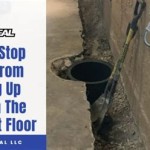How To Put A Sump Pump In Your Basement
A flooded basement can cause extensive damage to your home and belongings. Installing a sump pump is an effective way to prevent flooding and protect your basement from water damage. Sump pumps are relatively easy to install, but there are a few things you need to know before you get started.
Choosing the right sump pump
The first step is to choose the right sump pump for your needs. There are two main types of sump pumps: pedestal sump pumps and submersible sump pumps. Pedestal sump pumps are located outside of the sump basin, while submersible sump pumps are located inside the basin. Submersible sump pumps are more common and are generally more reliable than pedestal sump pumps.
The size of the sump pump you need will depend on the size of your basement and the amount of water that is likely to enter the basement. A general rule of thumb is to choose a sump pump that can pump at least 30 gallons of water per minute.
Installing the sump pump
Once you have chosen a sump pump, you need to install it in the basement. The sump pump should be installed in the lowest point of the basement, and it should be placed in a sump basin. The sump basin is a hole in the floor that is lined with a plastic or metal liner. The sump basin collects water from the basement and directs it to the sump pump.
To install the sump pump, first dig a hole in the floor that is large enough to fit the sump basin. The hole should be at least 18 inches wide and 24 inches deep. Once you have dug the hole, place the sump basin in the hole and level it. Next, connect the sump pump to the sump basin. The sump pump should be connected to the discharge pipe, which is a pipe that carries water away from the basement. The discharge pipe should be at least 1 inch in diameter and should be sloped downward so that water can flow out of the basement.
Testing the sump pump
Once you have installed the sump pump, you need to test it to make sure that it is working properly. To test the sump pump, pour a bucket of water into the sump basin. The sump pump should turn on and pump the water out of the basin. If the sump pump does not turn on, check the power cord to make sure that it is plugged in. If the power cord is plugged in, check the fuse or circuit breaker to make sure that it has not tripped.
Maintaining the sump pump
Sump pumps require regular maintenance to ensure that they are working properly. The following are some tips for maintaining your sump pump:
- Check the sump pump regularly to make sure that it is clean and free of debris.
- Test the sump pump every few months to make sure that it is working properly.
- Have the sump pump serviced by a qualified technician once a year.
By following these tips, you can help to ensure that your sump pump is working properly and that your basement is protected from flooding.

Diy Sump Pump Install Your Own Smd Fluid Controls

What Is A Sump Pump Peel Pumps Explain It Or Sell And Install Them

Diy Sump Pump Install Your Own Smd Fluid Controls

Basement Sump Pump Sedona Waterproofing Solutions

Sump Pump Installation How To Install A Homeserve Usa

How To Install A Sump Pump

Tips For Installing Sump Pumps 2024 10 17 Plumbing And Mechanical

Adding A Sump Pump To An Existing Basement American Dry Systems

Installing A Sump Pump In Our Basement Youtube

How To Install A Sump Pump Installation Hamilton
Related Posts







